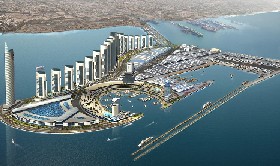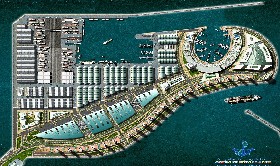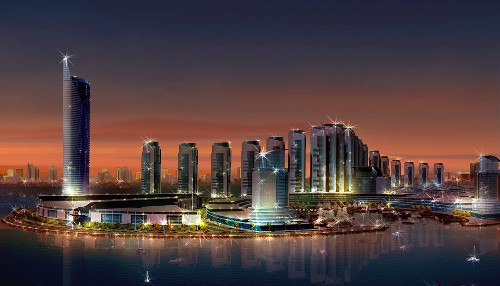|
Having brought Dubai into the
information and digital age with projects like Dubai
Internet City and Dubai Media City, the emirate is
looking to its past for another future area of growth
with the creation of Dubai Maritime City - an
integrated state-of-the-art development that will
provide every element of infrastructure required by key
marine and maritime related industries.
Like many
of the recent commercial developments in Dubai, Dubai
Maritime City will create a cluster of like-minded
companies, with six large and diverse sectors having
been identified for the facility: marine services;
marine management; product marketing; marine research
and education; recreation; ship design and
manufacturing. It is also destined to become an ideal
location for international trade seminars, exhibitions,
conferences and symposia related to the maritime
industry.
“As an iconic, multidimensional maritime centre, Dubai
Maritime City is committed to serving the needs of the
regional and global maritime community,” stated DMC
project manager Amer Ali. “By offering world-class
infrastructure, services and regulations, we will create
a unique specialised environment that will promote the
networking and integration of maritime players.”
With coastal land scarce in Dubai, the decision was
taken to reclaim land from the sea to house Dubai
Maritime City. In August 2003, dredging work began to
create a 25 million square feet man-made peninsula
between Dubai’s Port Rashid terminal and Dubai Drydocks
- with the peninsula connected to the mainland by a
causeway.
Utilising similar technology to that used to create The
Palm, dredging began on a 24-hour basis, with the
peninsula first breaking the surface on December 1,
2003. An estimated 30 million cubic metres of dredged
seabed sand and 2.5 million cubic metres of rock are
being used to create the peninsula, breakwaters and
other associated infrastructure.
The development has also required the relocation of the
Dubai Drydocks entrance channel and, consequently, the
main breakwater at the dry docks had be extended by
about 500 metres - creating a total breakwater length of
about 2,140 metres.
Following
the completion of the reclamation works, construction
will begin on the rest of the infrastructure in phases,
with the facility scheduled to open for business in
2006. Once complete, Dubai Maritime City will have four
key areas – a commercial area, a leisure area, a repair
area and a research and academy area.
The
commercial area will include a harbour, offices for
maritime-related businesses, banks, support services,
restaurants and a flexible exhibition site. The leisure
area will include berthing for yachts and a museum,
while the repair area will comprise a dockyard, ship
supply outlets, a ship repair area, a ship building
area, and a maritime retail area. Key components of the
repair yard will be two brand new ship lifts and state
of the art equipment, with the repair and ship building
side of the business to be expanded to include yacht and
dhow repair, in addition to steel work.


Marine research & education in the region will receive a
huge boost in the form of a marine academy within Dubai
Maritime City, while an oceanographic research centre
and naval history museum will add further educational
value.
While futuristic in outlook, Dubai Maritime City draws
upon the emirate’s long and proud maritime history, and
will expand the scope of business for local, regional
and international maritime companies already operating
in Dubai.
The city emerged as a trading entrepot in 1833 when
Sheikh Maktoum bin Buti began the Al Maktoum family’s
rule of Dubai. Realising the potential of Dubai Creek’s
natural harbour, he established a trading port along the
banks of the natural water inlet that splits the city
into Deira and Bur Dubai.
By the turn of the 20th Century, traders were re-routing
goods through Dubai to avoid the high customs elsewhere
in the region, with Persia’s principal port, Lingah,
particularly hard hit. To take advantage of the influx
of merchants, Sheikh Maktoum bin Hasher Al Maktoum
established Dubai as a free trade port, abolished import
and export tariffs, and began a systematic programme to
encourage Lingah's leading merchants to relocate.
He offered free land and personal guarantees of
protection in his peaceful trading haven and the economy
grew as smaller traders followed the more prominent
merchants and resettled in Dubai, which quickly
established itself as the Gulf’s leading entry port and
the centre of the pearling trade.
Another major milestone in Dubai’s maritime history came
in 1976 when the late Ruler of Dubai, Sheikh Rashid,
gave instructions for an ambitious project - the
construction of the world’s largest man-made harbour at
Jebel Ali. When completed in 1979, Jebel Ali Port ranked
alongside the Great Wall of China and the Hoover Dam as
the only three man-made objects that could be seen from
space.
With Jebel Ali firmly established as one of the world’s
busiest ports and Dubai as a global import and re-export
centre, Dubai Maritime City is looking to build on the
well-established maritime traditions of the emirate and
take them into the future.
“An advantage of DMC is that an array of diverse marine
service companies can operate as separate entities, but
in close proximity to their prime avenues of business,”
Mr Ali explained. “Dubai Maritime City has been
positioned as a facility that will develop and expand
existing maritime markets, forming a bridge between
overseas and regional maritime companies. It will also
offer the benefits of clustering, allowing shipping
related services to be closer to their partners and
customers.”

Dubai
Maritime City will enhance the city’s reputation as a
maritime destination and senior officials from DMC and
the Dubai World Trade Centre (DWTC) have recently
created a joint initiative to
develop a strategic plan to devise and organise
exhibitions, conferences and events that centre around
the increasingly high profile maritime industry.
DWTC Director General, Helal Saeed Khalfan Al Marri,
explained: “With Dubai’s growing status as the
commercial and maritime hub of the Middle East, we felt
the time was right to explore ways of creating a series
of world-class events revolving around the marine
industry, that will firmly establish the emirate as one
of the prime maritime destinations and a world leader in
maritime development.
“Our experience and success in organising the Dubai
International Boat Show has clearly demonstrated that
the marine industry in Dubai is set for tremendous
growth. Rapid marina development in the UAE is fuelling
demand for new boats. Ongoing projects that include
Dubai Marina, Dubai Festival City and the massive Palm
Island and World projects off the coast of Dubai will
add significantly to the number of marina berths
available.
“By working together with Dubai Maritime City we are
looking to capitalise on our respective areas of
expertise and build events that address key sectors of
the industry including commercial shipping,
shipbuilding, ship design, leisure boating, marine
management and marine services.”
With new companies signing up to join Dubai Maritime
City on an almost daily basis, the emirate’s future as a
regional shipping and marine hub looks set for even
further expansion, consolidating yet another commercial
sector in the leading business city in the Middle East.
| 